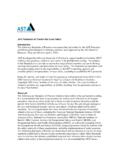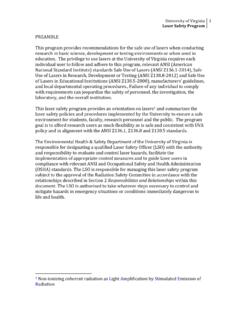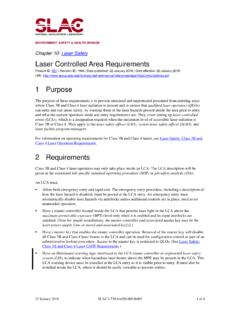Transcription of STANDARD OPERATING PROCEDURES FOR LASER …
1 1 UC Irvine Radiation Safety Division LASER Safety SOPs STANDARD OPERATING PROCEDURES FOR LASER SAFETY PRINCIPAL INVESTIGATOR: DEPARTMENT: BUILDING/ROOMS: LASER USERS: DATE: A. LASER SAFETY TRAINING There are two required components of LASER safety training: 1. Initial LASER safety training: This is conducted by EH&S via an online LASER Safety course ( ). All persons on campus who will be OPERATING Class 3b and/or Class 4 lasers are required to complete EH&S LASER safety training -- before starting to operate lasers. General LASER safety principles are covered including engineering, administrative and personal protective LASER safety controls, biological effects of LASER radiation, frequent causes of LASER accidents, non-beam hazards, and human behavioral factors as they relate to LASER safety.
2 2. On-the-job/hands-on training: This is to be conducted by the Principal Investigator or an experienced senior researcher in the laboratory. All persons must be provided with adequate on-the-job training so that they are sufficiently competent to operate their lasers independently and safely, and feel comfortable doing so. All appropriate operational PROCEDURES ( LASER system startup, alignment, shut-down, etc.) need to be covered in this training, including the needed safety equipment and other safety-related considerations. 2 UC Irvine Radiation Safety Division LASER Safety SOPs B. WARNING SIGNS AND ACCESS CONTROL All rooms in which lasers are operated must be posted with permanent door-type LASER warning signs that include all information appropriate to the lasers operated within the rooms ( , LASER types and classes, output characteristics).
3 Doorknob-type warning signs ( Do not enter , Alignment in progress , LASER OPERATING inside ) should be temporarily posted in cases when persons intending to enter rooms or enter LASER use areas need to be alerted regarding potentially enhanced hazards such as during beam alignments. LASER warning signs are available free of charge on request from EH&S. In cases in which illuminated LASER -on warning signs are purchased and installed outside LASER laboratories, these should only be turned on during LASER operation. Otherwise, they become part of the landscape and are ignored. Only persons needed to perform the studies are permitted in LASER use areas during LASER operation. All others, especially casual visitors, must be excluded. C. BEAM ALIGNMENT PROCEDURES Pre-alignment PROCEDURES Make sure that only persons who are authorized by the Principal Investigator or LASER supervisor and who need to be there during the alignment process are present.
4 Post a temporary beam alignment warning sign on the doorknob to the LASER laboratory and lock the door. Remove all unnecessary reflective items from the optical table and your person (shiny tools, extra mirrors, jewelry, watch, plastic ID card, etc.). Put on protective eyewear with adequate optical density. In some cases (low power visible beam only), low optical density alignment eyewear can be worn. Contact EH&S with any questions concerning protective eyewear. M-rated eyewear is needed for lasers with pulses < 1 nanosecond. Reduce the beam power as much as possible. Use a low-power (< 5 mW) visible beam LASER like a HeNe LASER or a diode LASER ( , a LASER pointer) to align the optics, whenever possible. Make sure all materials needed for the alignment are readily available and that you have carefully thought through the alignment procedure in advance so there will be no surprises that could increase the likelihood of an accident.
5 Isolate the beam from other areas of the laboratory using LASER curtains, beam barriers, and beam stops. Enclose as much of the beam as you can to protect your eyes and skin. 3 UC Irvine Radiation Safety Division LASER Safety SOPs During the alignment Use an indirect means of viewing the beam (beam detector card, infrared viewer scope, Zap-it paper) except when aligning low power (< 15 mW) visible beam lasers. Keep the beam on the plane of the optical table and well below normal sitting eye level. Never direct a beam upwardly or across a walkway! Do not leave a LASER OPERATING and unattended. Keep protective eyewear on during the entire process. Remember that special alignment eyewear is available for visible beam LASER use (only safe for output power up to about 100 mW). Contact EH&S for information on this type of eyewear.
6 Keep in mind that about half of all LASER accidents occur during alignment. Be careful! The most dangerous lasers are the near-infrared mode-locked and Q-switched lasers invisible or barely visible beams, very short pulse durations, and thus very high peak powers. Use a high degree of caution when aligning these lasers. [Note: As mentioned above, M-rated eyewear is needed to absorb picosecond and femtosecond-pulse LASER radiation. Contact EH&S for ordering information.] After the alignment Replace the enclosures or other safety barriers that were removed for the alignment. Remove temporary alignment doorknob warning sign. Always store your protective eyewear near the lasers for which it is worn such that it will not get scratched or broken. D. PROTECTIVE EYEWEAR Eyewear must be worn whenever there is a reasonable likelihood of exposure to a harmful level of LASER radiation.
7 Remember that protective eyewear is your last line of defense against LASER hazards engineering controls (beam enclosures, beam stops, beam tubes, beam barriers, beam dumps, LASER curtains, etc.) and administrative controls (like LASER safety training and these LASER safety SOPs) are the best ways to control hazards. Contact EH&S for assistance in selecting eyewear, including calculating the optical density (OD) needed for adequate protection. Complete a LASER Registration Form and return it to EH&S for assistance in determining the needed OD. 4 UC Irvine Radiation Safety Division LASER Safety SOPs The protective eyewear vendors below have good eyewear selections and excellent customer service. They supply STANDARD LASER eyewear and certified M-rated eyewear (for NoIR and Glendale only; Trinity M-rated*certification process underway), and they also give discounts on eyewear to educational institutions like UC Irvine: NoIR LASER Company Trinity Technologies Box 159, South Lyon, MI 48178 595 Phalen Blvd.
8 , St. Paul, MN 55101 Phone: 800-521-9746 ; Fax: 734-769-1708 Phone: 800-393-5565 ; Fax 651-357-1830 Web: Web: Kentek Corporation 1 Elm Street, Pittsfield, NH 03263 Phone: 800-432-2323 Web: Newport Corporation 1791 Deere Avenue, Irvine, CA 92606 Phone: 949-863-3144 Web: * M-rated eyewear is needed for ultrafast lasers (pulse duration < 1 nanosecond). E. CONTROL OF NON-BEAM HAZARDS 1. Electrical hazards Only persons experienced in electrical maintenance and repair may perform these tasks. EH&S offers a course in High Voltage Safety; interested persons can register at High voltage power supplies must only be serviced when personnel knowledgeable in performing cardiopulmonary resuscitation (CPR) are present. The Anteater Recreation Center on campus offers CPR and First Aid classes ( ).
9 2. Fire hazards Class 4 visible and infrared beams with irradiances above 10 W/cm2 can ignite combustible beam enclosure materials. Keep combustible materials, including organic solvents, away from LASER use areas. Never use cardboard or paper for high power visible or infrared beam containment. 5 UC Irvine Radiation Safety Division LASER Safety SOPs 3. Chemical hazards Fluorine and chlorine gases are used with excimer lasers. These need to be stored in approved ventilated gas cabinets. Dye solutions used with dye lasers need to be mixed in a properly functioning fume hood by personnel wearing a lab coat, impermeable gloves, and chemical safety eyewear. Material Safety Datasheets for toxic materials must be reviewed prior to using them: 4. LASER -generated air contaminants These are potentially-toxic substances generated when high power LASER beams strike target materials (plastic, tissue, etc.)
10 General/dilution ventilation and local exhaust ventilation are two means of controlling this hazard. In rare cases respirators need to be worn. 5. Collateral radiation Some LASER systems can generate x-rays, ultraviolet radiation, intense non-coherent visible radiation or radiofrequency radiation. Contact EH&S if you have any concerns regarding this. 6. Noise Some lasers can emit loud noise during pulsing. Contact the Industrial Hygiene Division of EH&S at 949-824-6200 for assistance with hearing protection and noise control methods. F. SUPERVISOR JUDGEMENT IN LASER SAFETY An intangible but critically important LASER safety issue has to do with the mental readiness of LASER operators to perform their studies. If a graduate student was awake the entire night studying for a final examination, that person would be a poor choice to operate a hazardous open-beam LASER the following day.










